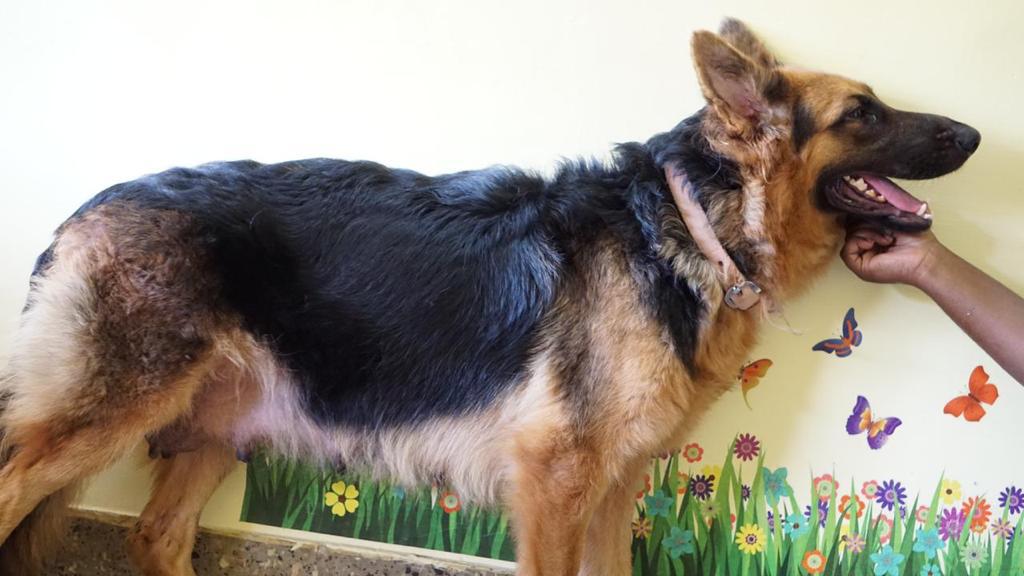How Cold Can a German Shepherd Tolerate?

German Shepherds are known for their thick double coats, which make them well-suited for cold weather. However, there is a limit to how much cold a German Shepherd can tolerate. In this article, we will discuss how cold German Shepherds can tolerate as well as factors that affect their cold tolerance. We will also provide tips on how to keep your German Shepherd warm in cold weather.
How German Shepherds Stay Warm
German Shepherds have a thick double coat that helps them stay warm in cold weather. The outer coat is made of long, coarse hairs that help trap heat, while the inner coat is made of short, soft hairs that provide insulation. German Shepherds also have a layer of fat under their skin that helps keep them warm.
How Cold Can a German Shepherd Tolerate?
The exact temperature at which a German Shepherd will start to get cold depends on a number of factors, including the dog’s age, health, and activity level. As a general guideline, German Shepherds can comfortably tolerate temperatures as low as 20°F to 30°F (-6°C to -1°C). They have a double coat consisting of an outer layer that provides protection from the elements and an undercoat that acts as insulation. This helps them retain body heat and stay warm in moderately cold conditions. At temperatures below 20 degrees Fahrenheit, German Shepherds are at risk of hypothermia and frostbite.
Is 30 Degrees Too Cold for a German Shepherd?
No! Although German Shepherds have a natural tolerance for cold weather, the specific temperature at which they might find it too cold can vary based on several factors. In general, a temperature of 30 degrees Fahrenheit (-1 degree Celsius) is not considered too cold for a healthy and properly acclimated German Shepherd.
Is 45 Degrees Too Cold for a German Shepherd?
Like we mentioned earlier, German Shepherds are generally well-suited for colder temperatures due to their double coat and natural cold tolerance. A temperature of 45 degrees Fahrenheit (7 degrees Celsius) is generally not considered too cold for a healthy and acclimated German Shepherd. However, it’s important to consider individual factors and other conditions that may affect their comfort and well-being.
Factors that Affect a German Shepherd’s Cold Tolerance
The following factors can affect a German Shepherd’s cold tolerance:
Age and Health Condition
Young puppies and senior German Shepherds are generally more sensitive to extreme temperatures. Their bodies may struggle to regulate temperatures efficiently, making them more vulnerable to the cold. In addition, dogs with underlying health conditions, such as arthritis or hypothyroidism, may have a reduced tolerance for cold weather.
Activity level
German Shepherd dogs that are more active tend to be better able to tolerate cold weather than those that are less active.
Coat and Undercoat
The German Shepherd’s double coat consists of a longer outer coat and a dense undercoat. This combination helps regulate body temperature by providing insulation. In general, dogs with a thicker undercoat have better cold tolerance. However, it’s important to note that excessive grooming or shaving the coat can compromise its insulating properties and make your German Shepherd more susceptible to the cold.
Body Fat Percentage
Body fat acts as an additional layer of insulation, helping German Shepherds stay warm in colder temperatures. German Shepherds with a healthy body fat percentage are better equipped to tolerate the cold. However, obesity can lead to other health issues, so it’s crucial to maintain a balanced diet and exercise routine to keep your dog at a healthy weight.
How to Keep Your German Shepherd Warm in Cold Weather
Here are some tips on how to keep your German Shepherd warm in cold weather:
- Provide a warm, dry place to sleep: Your German Shepherd’s bed should be in a draft-free area of your home. You may also want to consider getting a heated bed for your dog.
- Dress your dog for the weather: There are a number of winter coats and sweaters available for German Shepherds. Choose a coat that is made of a warm, breathable fabric.
- Avoid taking your dog for long walks in cold weather: If you do take your dog for a walk in cold weather, keep the walks short and brisk.
- Bring your dog inside if it starts to shiver: Shivering is a sign that your dog is cold. Bring your dog inside and warm it up with a warm blanket or heating pad.
Winter Care Tips for German Shepherds
In addition to the aforementioned protective measures, here are some general winter care tips for German Shepherds:
Regular Exercise
Continue providing regular exercise to keep your German Shepherd physically and mentally stimulated. Engaging in activities indoors, such as puzzle toys, obedience training, or interactive games, can help compensate for reduced outdoor time.
Grooming and Coat Maintenance
Regular grooming is essential to keeping your German Shepherd’s coat in good condition. Brushing helps remove loose hair and promotes healthy skin and coat. Additionally, it allows you to check for any signs of skin dryness or irritation.
Paw Care
Protect your dog’s paws from the cold, ice, and salt on the ground. Consider using dog booties or paw balms to prevent discomfort, frostbite, and chemical burns. After walks, wipe your German Shepherd’s paws with a damp cloth to remove any potentially harmful substances.
Indoor Activities
During cold weather, engage your German Shepherd in indoor activities that provide mental stimulation. These can include food puzzles, obedience training sessions, or teaching new tricks. Keeping your dog’s mind active is just as important as physical exercise.
Meanwhile, check out How to Make Your Dog’s Bed Cozy for Winter.
How do I know if my German Shepherd is cold?
Here are some signs that your German Shepherd may be cold:
- Shaking or shivering. This is a classic sign that your dog is feeling cold.
- Hunched posture with a tucked tail. When dogs are cold, they will often try to conserve heat by hunching their bodies and tucking their tails.
- Whining or barking. If your dog is whining or barking excessively, it could be a sign that they are feeling uncomfortable or cold.
- Change in behavior. If your dog is normally playful and energetic but seems lethargic or uninterested in activities, it could be a sign that they are cold.
- Reluctance to keep walking or trying to turn around. If your dog is on a walk and they start to slow down or try to turn around, it could be a sign that they are getting cold.
- Pale gums. If you check your dog’s gums and they are pale, it could be a sign that they are experiencing hypothermia.
- Slow, shallow breathing. If your dog’s breathing is slow and shallow, it could be a sign that they are getting cold.
- Loss of consciousness. If your dog is showing any of the above signs and then loses consciousness, it is a medical emergency, and you should seek veterinary help immediately.
If you notice any of these signs, it is important to bring your German Shepherd indoors and warm them up. You can do this by providing them with a warm blanket or towel or by using a heating pad. You can also give them warm water to drink. If your dog is still showing signs of being cold after a few hours, it is best to take them to the vet to be checked out.
Conclusion
That’s it for how much a German Shepherd dog can tolerate. Share the article if you like it. Meanwhile, check out more frequently asked questions about German Shepherds cold tolerance.
Frequently Asked Questions
Can German Shepherds survive in the cold?
Yes, German Shepherds can survive in cold weather. They have a thick double coat that helps them stay warm, even in temperatures below freezing. However, it’s important to take precautions to keep them warm, especially if you live in an area with extreme cold. Here are some tips:
- Dress them in a warm coat or sweater.
- Apply petroleum jelly to their paws to protect them from the cold and snow.
- Limit their time outdoors in extreme cold.
- Bring them indoors if they start to shiver or seem lethargic.
- Provide them with a warm, dry place to sleep.
- Make sure they have access to fresh, clean water.
If you follow these tips, your German Shepherd should be able to comfortably survive in cold weather.
Can a German Shepherd sleep outside in the cold?
Although we mentioned that German Shepherds have some natural adaptations for cold weather, it is generally not recommended for you to allow them to sleep outside in extremely cold temperatures. German Shepherds are better suited for sleeping indoors, where they can benefit from a warm and sheltered environment. If you expose your German Shepherd for a very long time to a cold temperature, it may be at risk of hypothermia, frostbite, and other cold-related health issues.
Can German Shepherds adapt to colder temperatures over time?
While German Shepherds can adapt to some extent, their tolerance for cold temperatures is largely dependent on their individual traits and health. It’s essential to provide them with the necessary care and protection rather than relying solely on acclimation.
Is it necessary to use dog coats for German Shepherds in the winter?
Not all German Shepherds require dog coats in winter, as their double coat provides insulation. However, in extremely cold conditions or for dogs with shorter coats, using a dog coat can provide an extra layer of warmth and protection.


